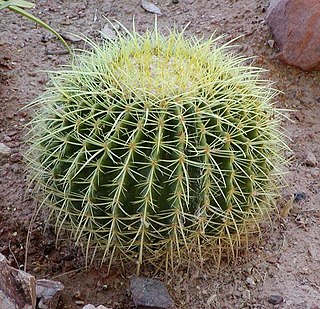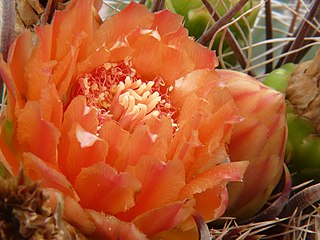
Barrel cacti are various members of the two genera Echinocactus and Ferocactus, found in the deserts of Southwestern North America. Some of the largest specimens can be found in the Mojave Desert in southern California.

Echinocactus is a genus of cacti in the subfamily Cactoideae. The generic name derives from the Ancient Greek εχινος (echinos), meaning "spiny," and cactus. It and Ferocactus are the two genera of barrel cactus. Members of the genus usually have heavy spination and relatively small flowers. The fruits are copiously woolly, and this is one major distinction between Echinocactus and Ferocactus. Propagation is by seed.

Ferocactus is a genus of large barrel-shaped cacti, mostly with large spines and small flowers. There are about 30 species included in the genus. They are found in the southwestern United States and northwestern Mexico.

Ethel M Botanical Cactus Garden is a 3-acre (1.2 ha) botanical garden located at the Ethel M Chocolate Factory in Henderson, Nevada. The garden, and the factory itself, are open to the public with no admission charge.

Fishhook cactus is a common name for any hook-spined species of the genera Mammillaria, Echinomastus or Sclerocactus. They are small cacti, usually growing up to 6-7 inches (20 cm) high, and are shaped similar to a barrel cactus. They are not to be confused with the fishhook barrel cactus of the Sonoran and Chihuahuan Deserts. The Fishhook cactus is a large category of around 150 species.

Echinocactus grusonii or Kroenleinia grusonii, popularly known as the golden barrel cactus, golden ball or mother-in-law's cushion, is a species of barrel cactus which is endemic to east-central Mexico.

Ferocactus wislizeni, the fishhook barrel cactus, also called Arizona barrel cactus, candy barrel cactus, and Southwestern barrel cactus, is a species of flowering plant in the cactus family Cactaceae, native to northern Mexico and the southern United States. It is a ball-shaped cactus eventually growing to a cylindrical shape, with spiny ribs and red or yellow flowers in summer.

Ferocactus cylindraceus is a species of barrel cactus which is known by several common names, including California barrel cactus, Desert barrel cactus, and miner's compass. It was first described by George Engelmann in 1853.

Ferocactus glaucescens, the glaucous barrel cactus, is a species of flowering plant in the family Cactaceae, native to the limestone hills of Hidalgo, endemic to México. It is a spherical or cylindrical cactus growing to 60 cm (24 in) in diameter, with long yellow spines and yellow flowers in summer.

Ferocactus viridescens is a species of flowering plant in the cactus family Cactaceae. This rare barrel cactus is known by several common names, including coast barrel cactus, keg cactus and San Diego barrel cactus. Most of its native range in the United States is in San Diego County, California, where it is threatened by development, agriculture, and other alterations in its habitat. It is also found in northern Baja California, Mexico.

Pseudoschinia is a genus of moths of the family Crambidae. It contains only one species, Pseudoschinia elautalis, which is found in North America, where it has been recorded from Arizona, California, Nevada, New Mexico and Texas.

Ferocactus latispinus is a species of barrel cactus native to Mexico. Originally described as Cactus latispinus in 1824 by English naturalist Adrian Hardy Haworth, it gained its current name in 1922 with the erection of the genus Ferocactus by American botanists Britton and Rose. The species name is derived from the Latin latus "broad", and spinus "spine". Ferocactus recurvus is a former name for the species.

Ferocactus peninsulae is a barrel cactus in the genus Ferocactus of the family Cactaceae.

Ferocactus robustus is a barrel cactus in the genus Ferocactus of the family Cacteae.

Ferocactus pilosus, also known as Mexican lime cactus or Mexican fire barrel, is a species of cactus in North America.

Ferocactus emoryi, known commonly as Emory's barrel cactus, Coville's barrel cactus and traveler's friend, is a barrel cactus in the genus Ferocactus.

Ferocactus fordii is a species of flowering plant in the family Cactaceae, native to Baja California in Mexico. It is spherical, growing to 50 cm (20 in) in diameter, with whitish-grey radial spines and solitary flowers of a deep rose pink, 4 cm (2 in) in diameter.

Ferocactus hamatacanthus, commonly named Turk's Head, is a barrel cactus in the tribe Cacteae.
Flora of the Sonoran Desert includes six subdivisions based on vegetation types. Two are north of the boundary between the United States and Mexico, and four are south of the boundary. The flora of the Colorado Desert are influenced by the environment of the very dry and hot lower areas of the Colorado River valley, which may be barren, treeless, and generally have no large cacti. Flora of the Arizona Upland are comparatively lush, with trees and large columnar cacti that can withstand winter frosts. South of the border subdivisions are characterized by plants that cannot withstand frost.


















